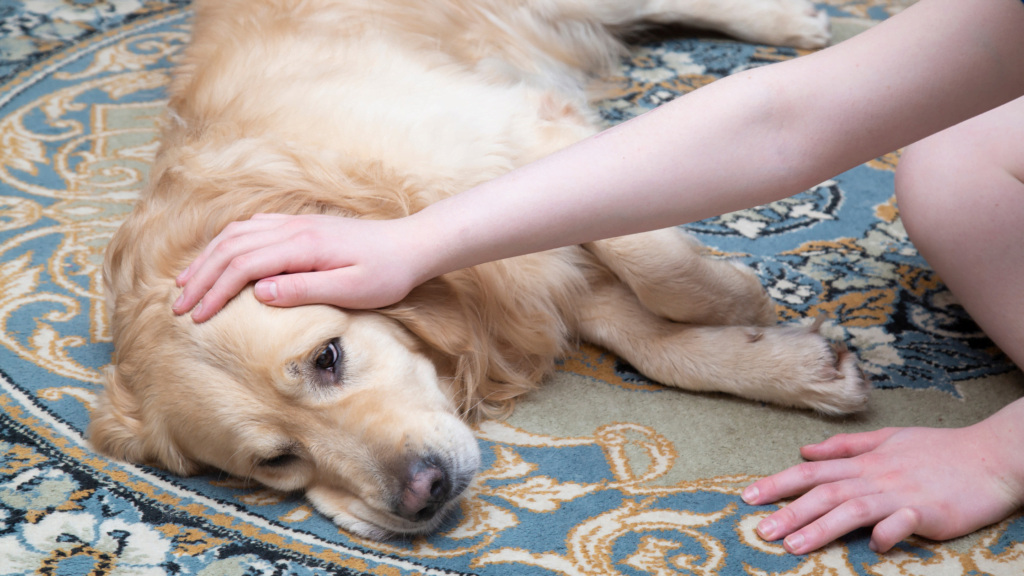Cerenia is a commonly prescribed medication used to treat vomiting in dogs. While it is generally considered safe and effective when used as directed, there are concerns about its potential risks and side effects. One question that dog owners may have is whether Cerenia can cause death or fatalities in dogs. In this article, we will explore the answer to the question “How Does Cerenia Kill a Dog?” and discuss the potential risks and side effects of Cerenia use in dogs.
What is Cerenia and How Does it Work?
Cerenia is a medication used in dogs to prevent vomiting and treat motion sickness. Its active ingredient is maropitant citrate, which works by blocking certain receptors in the brain that are responsible for inducing vomiting. This helps prevent nausea and vomiting in dogs and can be particularly useful for those who experience motion sickness or undergo chemotherapy. Cerenia is available in tablet form or as an injection and is typically prescribed by a veterinarian.
Why is Cerenia Prescribed for Dogs?
Cerenia is prescribed for dogs to prevent vomiting and treat motion sickness. It is commonly used in dogs who experience nausea and vomiting for various reasons, such as motion sickness during car rides or flights, gastrointestinal disorders, or postoperative nausea and vomiting. Additionally, Cerenia is sometimes used in dogs undergoing chemotherapy to prevent chemotherapy-induced vomiting. Cerenia is considered safe and effective when used as directed by a veterinarian.
How Does Cerenia Kill a Dog?
Cerenia is a medication used to treat vomiting and nausea in dogs. While it is generally considered safe, it can cause death in rare cases. The two possible causes of a dog’s death due to Cerenia are an allergic reaction to the drug and underlying disease that the prescription drug hid.
An allergic reaction to Cerenia can cause death in dogs, just like in people. It is important to watch for any signs of an allergic reaction, such as difficulty breathing, swelling of the face or tongue, or hives, and seek veterinary care immediately if these symptoms occur.
Another way that Cerenia can cause death in dogs is when pet owners fail to address or treat the underlying cause of vomiting. When a dog vomits, it is the body’s way of getting rid of harmful substances such as toxins, viruses, and bacteria. Cerenia inhibits vomiting and gets rid of toxins, making it seem like the dog is feeling better. Still, it does not address the underlying cause of the vomiting. Pet owners must only use Cerenia after their veterinarian has already ruled out other health issues.
Cerenia is a potent drug that should only be used as directed by a veterinarian. Overdose and incorrect dosing are the main causes of death related to Cerenia. To avoid any adverse reactions, it is crucial to follow your vet’s instructions and never exceed the recommended dose. If you notice any unusual symptoms or suspect your dog may have ingested too much Cerenia, seek veterinary attention immediately. Remember, an ounce of prevention is worth a pound of cure.
Also Read : The Ultimate Guide to Skull Dog Fursuits: A Comprehensive Guide for Pet Owners
Potential Risks and Side Effects of Cerenia Use in Dogs
Cerenia is considered safe for use in dogs when used as directed by a veterinarian. However, like any medication, it can cause side effects and potential risks in some dogs. Some of the potential side effects of Cerenia use in dogs may include:
- Diarrhea
- Lethargy
- Loss of appetite
- Vomiting
- Drooling
- Constipation
- Difficulty breathing
- Swelling of the face, lips, tongue, or throat
- Hives or rash
In rare cases, Cerenia can cause an allergic reaction, which can be life-threatening. Signs of an allergic reaction may include difficulty breathing, swelling of the face, lips, tongue, or throat, and hives. It is important to follow your veterinarian’s instructions when giving Cerenia to your dog and to contact them immediately if you notice any unusual symptoms or signs of an allergic reaction.
Understanding the Long-Term Effects of Cerenia Use on Dogs
Limited information is available about the long-term effects of Cerenia use in dogs. However, as with any medication, prolonged or excessive use of Cerenia may lead to potential risks and adverse effects. Long-term use of Cerenia may result in liver or kidney damage, although rare. Additionally, prolonged use of Cerenia may increase the risk of infection, as it may suppress the immune system. It is important to follow your veterinarian’s instructions when giving Cerenia to your dog and to only use it as prescribed. Suppose your dog requires long-term use of Cerenia. In that case, it is important to monitor them closely for any signs of side effects or adverse reactions and to discuss any concerns with your veterinarian.
What to Do If Your Dog is Prescribed Cerenia

If your dog is prescribed Cerenia, it is important to follow your veterinarian’s instructions. Cerenia is available in tablet form or as an injection and is typically prescribed based on your dog’s weight and the condition being treated. To ensure the safety and effectiveness of Cerenia, you should:
- Administer the medication as directed by your veterinarian.
- Monitor your dog for any signs of side effects or adverse reactions, and report them to your veterinarian.
- Do not give your dog more medication than prescribed, nor give Cerenia to other pets without consulting your veterinarian.
- Store Cerenia in a cool, dry place, away from direct sunlight and out of reach of children and pets.
- Do not crush or break Cerenia tablets, which can affect the medication’s efficacy.
It is important to keep all appointments with your veterinarian. At the same time, your dog takes Cerenia to monitor their progress and ensure the medication works as intended. Additionally, you should contact your veterinarian if you have any concerns or questions about Cerenia.
What to do if your dog experiences vomiting or diarrhea after taking Cerenia, and when to contact your veterinarian.
If your dog experiences vomiting or diarrhea after taking Cerenia, you should contact your veterinarian as soon as possible. They may advise you to temporarily stop the medication or adjust the dosage. Sometimes, your vet may recommend additional treatment, such as administering fluids or other medications. It’s important to closely monitor your dog’s condition and report any changes to your vet. If your dog shows signs of severe or persistent vomiting or diarrhea or appears to be in distress or discomfort, seek veterinary care immediately.
How to properly dispose of Cerenia or any other medication that is no longer needed or has expired.
Properly disposing of medication, including Cerenia, is important to prevent harm to people, animals, and the environment. To dispose of Cerenia, follow these steps:
- Check the medication’s label or package insert for specific disposal instructions.
- If no instructions are available, mix the medication with an unappealing substance such as used coffee grounds, dirt, or kitty litter in a sealed plastic bag or container.
- Place the sealed bag or container in your household trash.
- Remove or scratch any identifying personal information on the medication container before recycling or throwing it away.
- Do not flush medication down the toilet or drain, as this can contaminate water supplies.
If you are unsure how to properly dispose of Cerenia or any other medication, contact your local pharmacy or waste management facility for guidance.
Also Read : Can Dogs Eat Rice Safely? Expert Insights
How to prevent vomiting and nausea in dogs without medication.

There are several ways to prevent vomiting and nausea in dogs without medication. Here are a few:
- Change their diet: Switch to a bland diet of boiled chicken and rice or a prescription gastrointestinal diet, which can be easier to digest and less likely to cause upset.
- Feed smaller, more frequent meals: Feeding smaller meals more frequently throughout the day can help prevent nausea and vomiting by keeping the dog’s stomach from becoming too empty or too full.
- Avoid feeding right before or after exercise: Wait at least an hour before or after exercise before feeding your dog. This can help prevent nausea and vomiting when a dog’s stomach is too full or too empty during physical activity.
- Use natural remedies: Ginger, chamomile, and peppermint are all-natural remedies that help prevent nausea and vomiting in dogs. You can add these herbs to your dog’s food or give them as tea.
- Reduce stress: Stress can contribute to nausea and vomiting in dogs, so reducing stress levels can help prevent these symptoms. Ensure that your dog has a comfortable and quiet place to rest, and try to minimize stress-inducing factors in their environment.
It’s important to note that if your dog is experiencing frequent vomiting and nausea, it’s best to consult a veterinarian to rule out any underlying medical conditions.
How to recognize if your dog is experiencing motion sickness and what you can do to help them.

Some signs that your dog may be experiencing motion sickness include:
- Excessive drooling
- Yawning
- Whining or whimpering
- Licking their lips
- Vomiting or retching
- Inactivity or listlessness
To help your dog, you can try the following:
- Take shorter car rides more frequently to help your dog acclimate to being in the car.
- Ensure your dog has plenty of fresh air by cracking a window or turning on the air conditioning.
- Avoid feeding your dog right before a car ride, but also don’t let them go without food for too long.
- Consider using a dog car harness or crate to help your dog feel more secure during the ride.
- If necessary, talk to your veterinarian about using anti-nausea medication or natural remedies such as ginger or lavender oil.
Frequently asked questions
Here are some frequently asked questions about Cerenia use in dogs:
How long does Cerenia take to work?
Cerenia begins to work within 1 to 2 hours of administration and lasts 24 hours.
Can Cerenia be given with food?
Cerenia can be given with or without food.
Is Cerenia safe for puppies?
Cerenia is generally safe for puppies as long as it is used as directed by a veterinarian.
Can Cerenia be given to pregnant or nursing dogs?
The safety of Cerenia use in pregnant or nursing dogs has not been established, so it should be used with caution and only under the guidance of a veterinarian.
Can Cerenia be given to dogs with liver or kidney disease?
Cerenia should be used with caution in dogs with liver or kidney disease, as it is metabolized by the liver and excreted by the kidneys. Your veterinarian may adjust the dose or frequency of Cerenia administration based on your dog’s condition.
Can Cerenia be given with other medications?
Cerenia can interact with some medications, so it is important to inform your veterinarian of any other medications your dog takes before giving Cerenia.
Is Cerenia effective for all types of vomiting in dogs?
Cerenia is most effective for vomiting caused by motion sickness or certain gastrointestinal disorders. It may not be effective for vomiting caused by other conditions or diseases. Your veterinarian can help determine if Cerenia is appropriate for your dog’s specific condition.
Conclusion: Is Cerenia Safe for Dogs?
Cerenia is generally considered safe for use in dogs when used as directed by a veterinarian. It is an effective medication for treating vomiting caused by motion sickness or certain gastrointestinal disorders. However, like any medication, there are potential risks and side effects associated with Cerenia use, and it may not be appropriate for all dogs. It is important to follow your veterinarian’s instructions when administering Cerenia to your dog, monitor them for any signs of side effects or adverse reactions, and contact your veterinarian immediately if you have any concerns or notice any unusual symptoms. With proper use and monitoring, Cerenia can be a safe and effective treatment option for vomiting in dogs.

